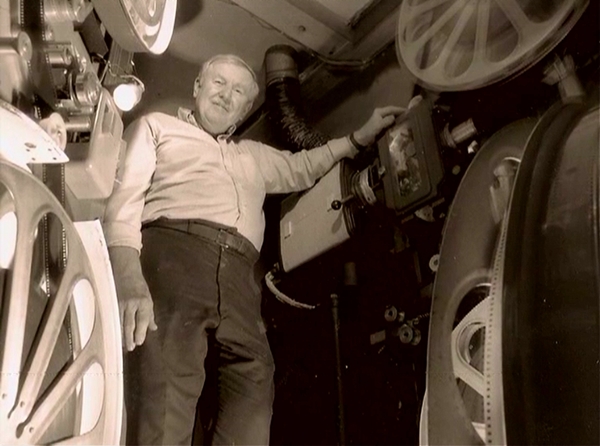 Let us now praise John Harvey.
Let us now praise John Harvey.
Somewhere in my scattered stacks of pre-digital photographs, I have a picture I took of John Harvey posing proudly beside one of his Cinerama projectors. I’ve been ransacking the house for over three months now, all the time I’ve been preparing and posting this series on Cinerama, and I absolutely cannot find the damned thing, or any of the other pictures I took on my visit to John’s home town of Dayton, Ohio in 1996. So I’ve given up and decided to make do with this image from the supplemental materials on the This Is Cinerama Blu-ray. I’ll keep looking, because it’s important: I knew from the start that this whole series was going to culminate in a grateful tribute to John. Besides, those pictures aren’t just important to me. They’re historic.
Not to mince words or beat around the bush, John Harvey is the man who — virtually single-handedly — preserved Cinerama for posterity. His service to movie history can scarcely be overstated.
This is not in any way to minimize or overlook the efforts of others who have often worked above-and-beyond to ensure the survival of Fred Waller’s marvel. Just a few examples: The International Cinerama Society was instrumental in seeing that Cinerama was installed at the
National Media Museum (formerly the National Museum of Photography, Film and Television) in Bradford, UK. John Sittig, who recently retired as Director of Projection and Sound for ArcLight Cinemas, performed a similar service for the installation of Cinerama at ArcLight’s Cinerama Dome in Hollywood (he also capped his career by putting together last month’s 60th Anniversary Cinerama Festival at the Dome). David Strohmaier’s 2002 documentary
Cinerama Adventure was — besides being one of the best movie-themed documentaries ever made — a major step in retrieving the forgotten process from the memory hole of the 1950s and ’60s (Strohmaier also wrote, directed and edited the 30-minute short
In the Picture [2012], the first picture in Cinerama since
How the West Was Won).
And Australian collector John Mitchell has done much at his end of the globe — it was his prints of Search for Paradise and The Wonderful World of the Brothers Grimm that screened at the festival in Hollywood. But before any of them except John Mitchell Down Under — back when the ICS was still scouring the world for parts to put in that museum in Bradford, when David Strohmaier was just beginning to wonder what ever happened to Cinerama — John Harvey had been hosting screenings of This Is Cinerama and How the West Was Won for years. In his living room.
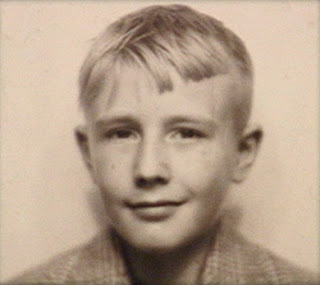
Harvey’s interest in the movie projectionist’s craft began at an early age in Dayton. At the age of 10 he’d tag along when his older brother went to work at the local drive-in theater, and he began to wonder about the kind of machine it would take to project movies onto that massive outdoor screen. The projectionist noticed him peering in the windows night after night, invited him in to have a look around, and became his mentor, eventually sponsoring him into the projectionists’ union when John turned 17.
Meanwhile, when John was 16, his father (a loyal fan of Lowell Thomas) had taken the family to see This Is Cinerama when it opened at Cincinnati’s Capitol Theatre in 1954. For a boy with a budding interest in movie projection, here was movie projection on steroids; in time he would travel the 54 miles to Cincinnati to see all the Cinerama features at the Capitol. And when Dayton’s Dabel Theatre converted to Cinerama in 1963, John — now a union projectionist — worked backup to the Dabel’s crew, seeing How the West Was Won for 38 straight weeks and getting hands-on experience running a Cinerama setup.
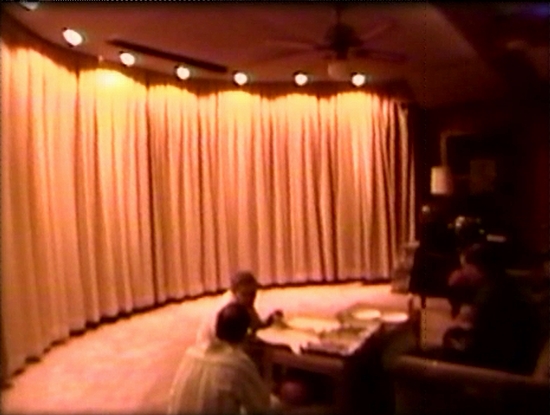
When three-strip Cinerama was abandoned after
HTWWW, Harvey missed it. He saw clearly the difference with the “new” Cinerama movies like
It’s a Mad, Mad, Mad, Mad World and
The Greatest Story Ever Told (really only UltraPanavision — a big picture on a curved screen, but the viewer was no more “in” the picture than if he were standing in front of a billboard by the side of the road).
Harvey’s home cinema began as a a sort of laboratory where he experimented with ways of keeping a single wide-screen frame in focus on a deeply curved screen. He enlarged his living room three-fold by knocking out the walls of two unused bedrooms and raising the ceiling, installed a 35mm projector, and began tinkering with lenses, mirrors, beam-splitters and screen surfaces. Eventually — and I’m speculating here, but it may have been when he finally realized that classic Cinerama was never coming back — he decided to convert his home theater to Cinerama. “One day,” he remembered, “I finally took the initiative: ‘I’m gonna build my own projectors; I’m gonna run that film.’ Because it hadn’t been seen for years.”
And he did. It took him years of patient accumulation and painstaking work, but he eventually installed three full-size Cinerama projectors — sometimes having parts made from scratch when he couldn’t find them — and a Cinerama sound console the size of an armoire (the set-up even encroached on his kitchen). He tracked down snippets of film all over the world, splicing them together as they came into his hands (the sheer magnitude of that chore is mind-boggling). In time he had complete prints of This Is Cinerama, Cinerama Holiday and How the West Was Won. That’s at the very least; I seem to remember reading somewhere that he acquired, bit by bit, all seven features, but I can’t document that now. At any rate, he also amassed an impressive array of Fred Waller’s original test footage from the 1940s, and even a print of a Renault car commercial made to play with How the West Was Won in France. In addition, he had a museum’s worth of Cinerama memorabilia: posters, programs, lobby cards, stills — he even served guests popcorn in baskets lined with Cinerama napkins. Throughout the 1980s, to put it bluntly, John Harvey’s suburban Ohio home was one of only two functioning Cinerama theaters in the world; the other was in Australian John Mitchell’s backyard, 9,400 miles away. (It was about this time that I read of John and his happy obsession; I daydreamed about meeting him and wangling an invitation for a screening or two. If I had only known: I probably had only to look him up in Dayton directory assistance and drop him a line. In the end it didn’t come to that — but I’m getting ahead of my story.)

In the early 1980s a mutual friend invited Larry Smith to a screening at John’s home and introduced the two men. Smith remembered seeing Cinerama at the Dabel at the age of six, and his experience that night was a reunion with one of his most vivid childhood memories. He told Harvey that if there was any way he (Larry) could help bring this to a wider audience, he wanted to do it. In 1986, Smith became the manager of the New Neon Movies, a cozy little 300-seat art cinema nestled in one corner of a huge parking garage in downtown Dayton, and began a ten-year campaign to persuade Harvey to install his Cinerama equipment at the New Neon. (This picture, by the way, is a rather misleading likeness of Larry. It’s from a 1997 interview taken while Kenneth Branagh’s
Hamlet was playing at the New Neon, and Larry had bleached his hair and grown the moustache and soul-patch to emphasize his slight resemblance to Branagh as the Melancholy Dane.)
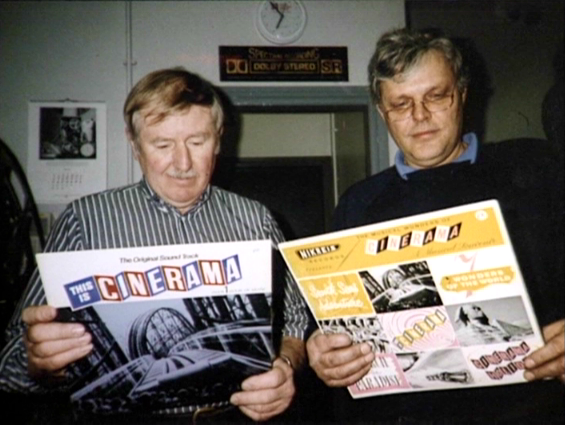
In John’s search for film and equipment, he had made the acquaintance of Willem Bouwmeester of the Netherlands. Like Harvey, Bouwmeester discovered Cinerama as a teenager and never lost his enthusiasm for the process. He grew up to work for IMAX in Europe and become a founding member of the International Cinerama Society, and from the Continent he had helped Harvey in his search. In 1993, when the ICS installed Cinerama at the Bradford museum, they sought and received advice and assistance from John Harvey. So now John’s house was no longer the lone outpost in a Cinerama-bereft world. But the only true Cinerama theater was in England; Cinerama remained a prophet without honor in the country of its origin (where it had once proved to be an honor without profit).
 As 1995 became 1996, the landlord of the New Neon Movies announced plans to split the already-modest theater down the middle and turn it into a two-screen venue. Larry Smith at last persuaded John it was now or never, and they hatched a plan that was brilliant simplicity itself: Before the remodel, the New Neon would install John Harvey’s screen, projectors and sound equipment. The theater would continue showing its standard art-house fare every evening, but on weekends there would be full-Cinerama matinees of This Is Cinerama (on Saturdays) and How the West Was Won (Sundays). The landlord was doubtful the scheme would pay for itself, but he agreed to let Smith solicit a letter-writing campaign; if he could get 1,000 writers to pledge to come to Dayton for Cinerama, then they could talk.
As 1995 became 1996, the landlord of the New Neon Movies announced plans to split the already-modest theater down the middle and turn it into a two-screen venue. Larry Smith at last persuaded John it was now or never, and they hatched a plan that was brilliant simplicity itself: Before the remodel, the New Neon would install John Harvey’s screen, projectors and sound equipment. The theater would continue showing its standard art-house fare every evening, but on weekends there would be full-Cinerama matinees of This Is Cinerama (on Saturdays) and How the West Was Won (Sundays). The landlord was doubtful the scheme would pay for itself, but he agreed to let Smith solicit a letter-writing campaign; if he could get 1,000 writers to pledge to come to Dayton for Cinerama, then they could talk.
Ads went out in movie-buff publications all over the country, things like Classic Images and Films of the Golden Age, soliciting interest. By the deadline Smith had received 1,200 expressions of interest and pledges to attend; the next day another 200 arrived. “Can you say ‘no’ to fourteen hundred people at once?” Smith asked. And so the project got a green light — but only for an eight-week run.
Smith, Harvey and the New Neon staff had thirty days and almost no budget to retrofit the theater for Cinerama — something that had often taken months and as much as 200,000 1950s dollars to do when Cinerama was new. They did it with long hours and volunteer workers (“We can’t pay you,” Smith said, “but we can give you all the popcorn you can eat.”), ripping out 80 of the 300 seats to make way for the screen and auxiliary projection booth spanning the full back of the auditorium. As opening night drew near the story of their project made the Associated Press wire, drawing interest from all over the continent: Texas, Florida, Canada, New Orleans, Washington DC. “It just didn’t stop,” Smith remembered. “We had so many interviews that first week, we wondered if we’d ever get around to showing the movies.”
This Is Cinerama premiered a second time in America — and for the first time in over 30 years — at the New Neon on Thursday, August 29, 1996. The date was chosen to take advantage of the long Labor Day Weekend, but Harvey and Smith were in store for an eerie surprise. The guest of honor that night was Marianna Munn Thomas, widow of Lowell, and they learned from her that they had, without knowing it, brought This Is Cinerama back to America on the fifteenth anniversary of Lowell Thomas’s death.
Now that’s what I call some kinda Karma.
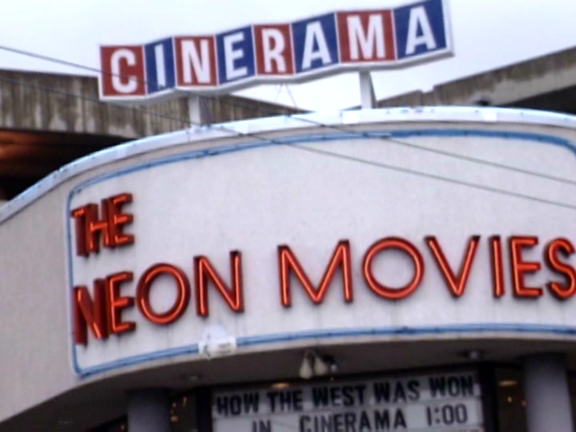
I’ll never forget how I learned about the project. That summer of ’96, when my girlfriend LuAnn and I returned from vacation in Illinois and Indiana, we were picked up at the Sacramento airport by my uncle, himself on vacation from his home in Muncie, Indiana — the same uncle who had taken my parents and grandparents to see
This Is Cinerama in San Francisco in 1953. As I sat down in the car, he dropped an issue of Classic Images in my lap, open to an ad announcing the eight-week return of
This Is Cinerama and
How the West Was Won. I stared, gobsmacked, for a few seconds, and once I realized it wasn’t some kind of trick, I turned to my uncle and said, “Let’s go.”
In October ’96, midway through the (supposedly) limited run, that’s what we did. I flew to my uncle’s home in Muncie, and from there we drove the 84 miles to Dayton. That’s when I met John Harvey and Larry Smith, and when I took all those pictures that I can’t find now.* And that’s when I had an experience I never expected to have again: seeing This Is Cinerama and How the West Was Won in honest-to-goodness Cinerama, the way Fred Waller and Lowell Thomas and Merian C. Cooper and Hazard Reeves and Henry Hathaway and everybody else intended them to be seen.
Improvements in projection technology — and John Harvey’s almost supernatural rapport with his own equipment — made it possible for him now to do alone what had once taken an entire team of projectionists, and both movies came off without a hitch. John’s print of How the West Was Won was simply flawless: richly brilliant colors without a scratch, splice or line from the first frame to the last. I saw HTWWW four times in Cinerama in 1963 and ’64, and I’ve seen it four more times since the revival of the Cinerama Dome in Hollywood, but I never saw it looking better — or even as good — as it did that Sunday in Dayton.
This Is Cinerama was more variable, having clearly been assembled from more disparate sources. There were a number of splices, a few scratches, and a second or two here and there (no more than 10 or 15 seconds overall) when a section of one of the three panels couldn’t be found and had to be filled in with black slugs. (There were even a few seconds, in the canals of Venice if memory serves, imprinted with Danish subtitles — this footage no doubt obtained through the efforts of Willem Bouwmeester.) Even so, it was the real article, no doubt about it; for 23 years I had carried the unhappy memory of the picture’s misbegotten 70mm reissue in 1973 — which should have been called This Isn’t Cinerama — and this erased it completely.
Chatting with Larry Smith in the lobby, it was clear that, no matter what the ads said about “for 8 weeks only”, he intended to keep Cinerama playing at the New Neon until the landlord dragged the projectors, the sound console and the screen out the front door and threw them into the street. And that’s pretty much what happened.
People came — no exaggeration — from all over the world; the original eight weeks got extension after extension. After a year, the New Neon’s Cinerama matinees were still selling out seven and eight weeks in advance, and the shows continued. On at least one occasion Smith and Harvey screened John’s print of the second feature, Cinerama Holiday (rather badly faded Eastman color, but complete) and the guests of honor were the Marshes (now divorced) and the Trollers, the couples who had starred in it back in 1954. Ultimately, the New Neon’s Cinerama engagement lasted nearly four years of weekends and special occasions, finally drawing to a close in April 2000.
Eventually, the landlord followed through on his original plan, and the New Neon is now a two-screen cinema incapable of showing Cinerama. Larry Smith has moved on; he now lives in Culpeper, Virginia, where he works in the film preservation unit of the Library of Congress, specializing in the salvage and preservation of nitrate film.
John Harvey suffered a series of health issues in the early 2000s, and was forced to sell off his Cinerama equipment, prints and memorabilia to pay his medical bills. He finally lost his battle with those issues on May 3, 2018, at the age of 81. But the seeds of his quest and crusade to preserve Cinerama have borne priceless fruit. His and Larry Smith’s phenomenal success in Dayton from 1996 to 2000 sparked renewed interest in Fred Waller’s lifework. Now, in addition to the National Media Museum in Bradford, there are the ArcLight Cinerama Dome in Hollywood and the Cinerama in Seattle; both had been slated for demolition before public enthusiasm for Cinerama saved them from the wrecking ball, and both were fitted for Cinerama with John’s advice and assistance. Those two theaters owe their new lease on life — and the one in Bradford owes its very existence — in no small measure to the dedication, enthusiasm and practical know-how of John Harvey.
___________________
*Those pictures may yet turn up; stranger things have happened. If they do, I’ll add them here.
* * *
UPDATE 8/4/13: As always seems to happen, the photographs I took on my trip to Dayton in October 1996 turned up when I least expected to run across them. Here are a couple of good examples.
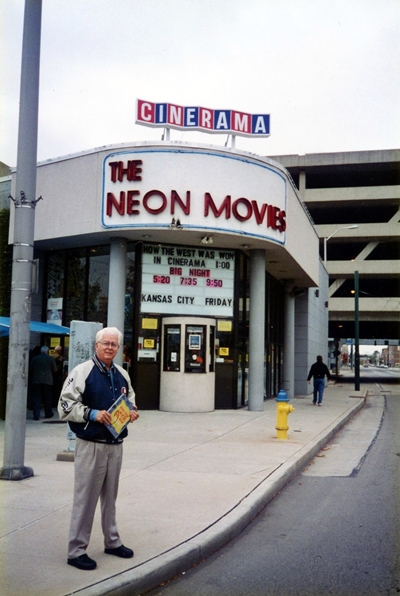
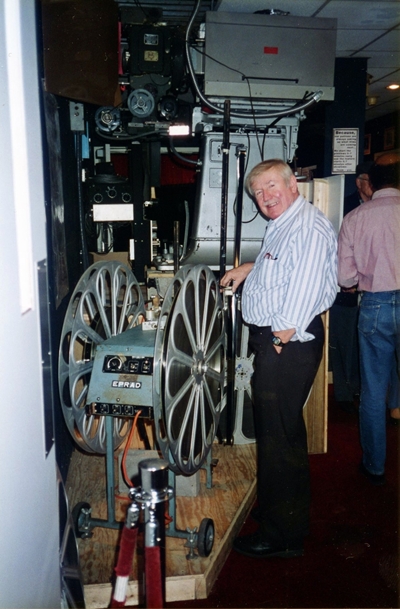
First, a shot of my uncle standing in front of the New Neon Movies as we arrived for the Sunday matinee showing of How the West Was Won. He’s holding one of my souvenir programs for the picture.
Just so there’s no confusion about the marquee over the box office: The New Neon ran This Is Cinerama on Saturday and How the West Was Won on Sunday afternoons. The rest of the week, and Saturday and Sunday evening, was devoted to current art-house fare. The marquee shows that the (regular) feature is Big Night, the 1996 hit starring Stanley Tucci and Tony Shalhoub as brothers operating a failing Italian restaurant. Opening on the coming Friday will be Robert Altman’s jazz-flavored Kansas City.
And here, finally, is the picture I originally wanted to open this post. This was taken the day before, in the “auxiliary” projection booth set up at the rear of the New Neon’s auditorium. It’s after the showing of This Is Cinerama, and John is carefully monitoring the rewinding of the second half of the feature.
 Let us now praise John Harvey.
Let us now praise John Harvey. Harvey’s interest in the movie projectionist’s craft began at an early age in Dayton. At the age of 10 he’d tag along when his older brother went to work at the local drive-in theater, and he began to wonder about the kind of machine it would take to project movies onto that massive outdoor screen. The projectionist noticed him peering in the windows night after night, invited him in to have a look around, and became his mentor, eventually sponsoring him into the projectionists’ union when John turned 17.
Harvey’s interest in the movie projectionist’s craft began at an early age in Dayton. At the age of 10 he’d tag along when his older brother went to work at the local drive-in theater, and he began to wonder about the kind of machine it would take to project movies onto that massive outdoor screen. The projectionist noticed him peering in the windows night after night, invited him in to have a look around, and became his mentor, eventually sponsoring him into the projectionists’ union when John turned 17. When three-strip Cinerama was abandoned after HTWWW, Harvey missed it. He saw clearly the difference with the “new” Cinerama movies like It’s a Mad, Mad, Mad, Mad World and The Greatest Story Ever Told (really only UltraPanavision — a big picture on a curved screen, but the viewer was no more “in” the picture than if he were standing in front of a billboard by the side of the road).
When three-strip Cinerama was abandoned after HTWWW, Harvey missed it. He saw clearly the difference with the “new” Cinerama movies like It’s a Mad, Mad, Mad, Mad World and The Greatest Story Ever Told (really only UltraPanavision — a big picture on a curved screen, but the viewer was no more “in” the picture than if he were standing in front of a billboard by the side of the road). In the early 1980s a mutual friend invited Larry Smith to a screening at John’s home and introduced the two men. Smith remembered seeing Cinerama at the Dabel at the age of six, and his experience that night was a reunion with one of his most vivid childhood memories. He told Harvey that if there was any way he (Larry) could help bring this to a wider audience, he wanted to do it. In 1986, Smith became the manager of the New Neon Movies, a cozy little 300-seat art cinema nestled in one corner of a huge parking garage in downtown Dayton, and began a ten-year campaign to persuade Harvey to install his Cinerama equipment at the New Neon. (This picture, by the way, is a rather misleading likeness of Larry. It’s from a 1997 interview taken while Kenneth Branagh’s Hamlet was playing at the New Neon, and Larry had bleached his hair and grown the moustache and soul-patch to emphasize his slight resemblance to Branagh as the Melancholy Dane.)
In the early 1980s a mutual friend invited Larry Smith to a screening at John’s home and introduced the two men. Smith remembered seeing Cinerama at the Dabel at the age of six, and his experience that night was a reunion with one of his most vivid childhood memories. He told Harvey that if there was any way he (Larry) could help bring this to a wider audience, he wanted to do it. In 1986, Smith became the manager of the New Neon Movies, a cozy little 300-seat art cinema nestled in one corner of a huge parking garage in downtown Dayton, and began a ten-year campaign to persuade Harvey to install his Cinerama equipment at the New Neon. (This picture, by the way, is a rather misleading likeness of Larry. It’s from a 1997 interview taken while Kenneth Branagh’s Hamlet was playing at the New Neon, and Larry had bleached his hair and grown the moustache and soul-patch to emphasize his slight resemblance to Branagh as the Melancholy Dane.) In John’s search for film and equipment, he had made the acquaintance of Willem Bouwmeester of the Netherlands. Like Harvey, Bouwmeester discovered Cinerama as a teenager and never lost his enthusiasm for the process. He grew up to work for IMAX in Europe and become a founding member of the International Cinerama Society, and from the Continent he had helped Harvey in his search. In 1993, when the ICS installed Cinerama at the Bradford museum, they sought and received advice and assistance from John Harvey. So now John’s house was no longer the lone outpost in a Cinerama-bereft world. But the only true Cinerama theater was in England; Cinerama remained a prophet without honor in the country of its origin (where it had once proved to be an honor without profit).
In John’s search for film and equipment, he had made the acquaintance of Willem Bouwmeester of the Netherlands. Like Harvey, Bouwmeester discovered Cinerama as a teenager and never lost his enthusiasm for the process. He grew up to work for IMAX in Europe and become a founding member of the International Cinerama Society, and from the Continent he had helped Harvey in his search. In 1993, when the ICS installed Cinerama at the Bradford museum, they sought and received advice and assistance from John Harvey. So now John’s house was no longer the lone outpost in a Cinerama-bereft world. But the only true Cinerama theater was in England; Cinerama remained a prophet without honor in the country of its origin (where it had once proved to be an honor without profit). As 1995 became 1996, the landlord of the New Neon Movies announced plans to split the already-modest theater down the middle and turn it into a two-screen venue. Larry Smith at last persuaded John it was now or never, and they hatched a plan that was brilliant simplicity itself: Before the remodel, the New Neon would install John Harvey’s screen, projectors and sound equipment. The theater would continue showing its standard art-house fare every evening, but on weekends there would be full-Cinerama matinees of This Is Cinerama (on Saturdays) and How the West Was Won (Sundays). The landlord was doubtful the scheme would pay for itself, but he agreed to let Smith solicit a letter-writing campaign; if he could get 1,000 writers to pledge to come to Dayton for Cinerama, then they could talk.
As 1995 became 1996, the landlord of the New Neon Movies announced plans to split the already-modest theater down the middle and turn it into a two-screen venue. Larry Smith at last persuaded John it was now or never, and they hatched a plan that was brilliant simplicity itself: Before the remodel, the New Neon would install John Harvey’s screen, projectors and sound equipment. The theater would continue showing its standard art-house fare every evening, but on weekends there would be full-Cinerama matinees of This Is Cinerama (on Saturdays) and How the West Was Won (Sundays). The landlord was doubtful the scheme would pay for itself, but he agreed to let Smith solicit a letter-writing campaign; if he could get 1,000 writers to pledge to come to Dayton for Cinerama, then they could talk. I’ll never forget how I learned about the project. That summer of ’96, when my girlfriend LuAnn and I returned from vacation in Illinois and Indiana, we were picked up at the Sacramento airport by my uncle, himself on vacation from his home in Muncie, Indiana — the same uncle who had taken my parents and grandparents to see This Is Cinerama in San Francisco in 1953. As I sat down in the car, he dropped an issue of Classic Images in my lap, open to an ad announcing the eight-week return of This Is Cinerama and How the West Was Won. I stared, gobsmacked, for a few seconds, and once I realized it wasn’t some kind of trick, I turned to my uncle and said, “Let’s go.”
I’ll never forget how I learned about the project. That summer of ’96, when my girlfriend LuAnn and I returned from vacation in Illinois and Indiana, we were picked up at the Sacramento airport by my uncle, himself on vacation from his home in Muncie, Indiana — the same uncle who had taken my parents and grandparents to see This Is Cinerama in San Francisco in 1953. As I sat down in the car, he dropped an issue of Classic Images in my lap, open to an ad announcing the eight-week return of This Is Cinerama and How the West Was Won. I stared, gobsmacked, for a few seconds, and once I realized it wasn’t some kind of trick, I turned to my uncle and said, “Let’s go.”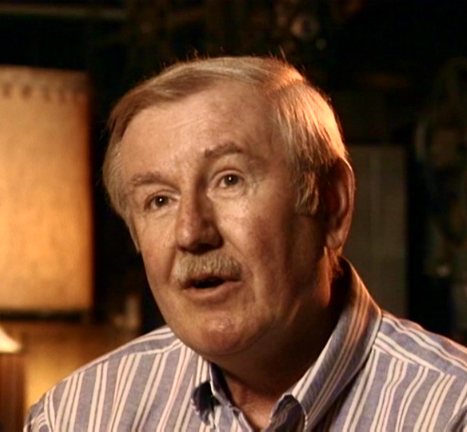


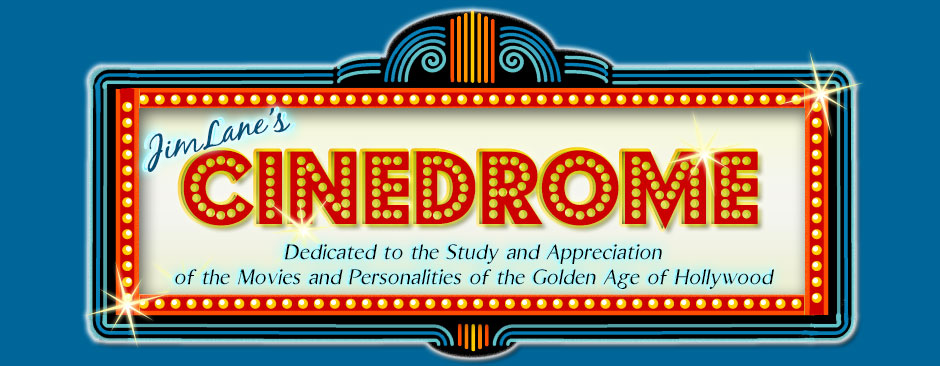
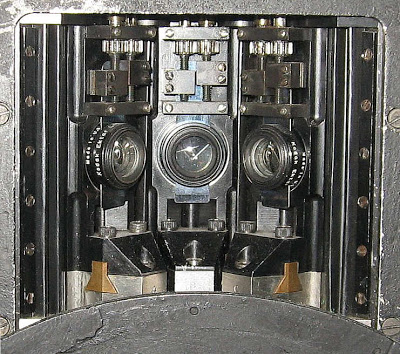
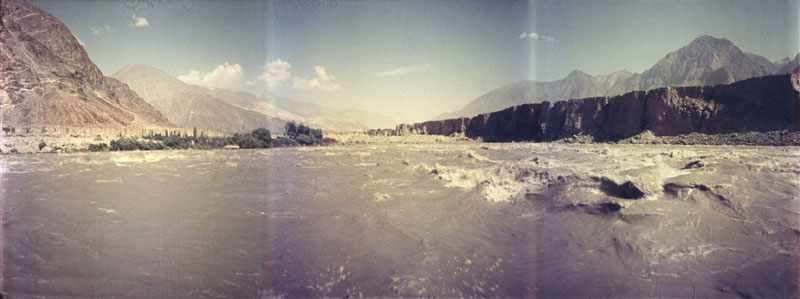 Some of Cinerama’s technical problems can be discerned in this frame (frames, actually) from Search for Paradise — although to be fair, by the time this picture was shot most of them had been considerably alleviated. Most often complained about were those dividing lines between the three panels. The panels overlapped by a degree or two, which meant that the overlap area would inevitably get the light from two projectors. To minimize this over-exposure, the sides of each projector’s film gate were supplied with little devices called (spellings vary) “gigolos”. These were serrated, comb-like assemblies mounted on cams that moved them up and down, once for each frame (i.e., 26 times per second) as the film passed through the gate. This was intended to cut down on the excess light hitting the overlap, and to blur the sharp division from one panel to the next. As a matter of fact, this worked reasonably well.
Some of Cinerama’s technical problems can be discerned in this frame (frames, actually) from Search for Paradise — although to be fair, by the time this picture was shot most of them had been considerably alleviated. Most often complained about were those dividing lines between the three panels. The panels overlapped by a degree or two, which meant that the overlap area would inevitably get the light from two projectors. To minimize this over-exposure, the sides of each projector’s film gate were supplied with little devices called (spellings vary) “gigolos”. These were serrated, comb-like assemblies mounted on cams that moved them up and down, once for each frame (i.e., 26 times per second) as the film passed through the gate. This was intended to cut down on the excess light hitting the overlap, and to blur the sharp division from one panel to the next. As a matter of fact, this worked reasonably well.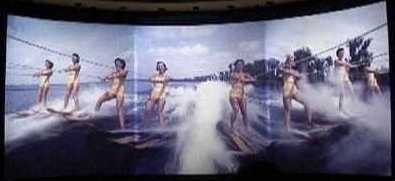
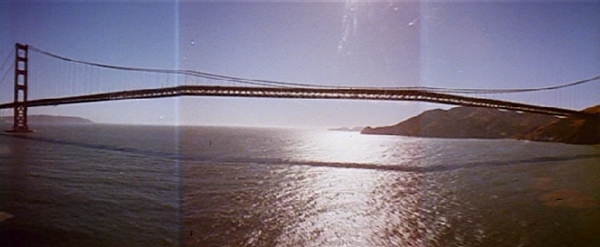 Most noticeable of all was the parallax effect caused by the fact that the Cinerama camera was really three cameras, each with its own vanishing point. (“parallax [pár-a-laks] n. 1 the apparent difference in the position or direction of an object caused when the observer’s position is changed.”) Imagine yourself looking out at a vista: First you look straight ahead; then you take a step to your right and turn your head left; then two steps left and turn your head right. You’re looking at the same view each time, but from three ever-so-slightly different places. That’s parallax. Take this frame on the right, from the last scene of How the West Was Won, flying under the Golden Gate Bridge. The join lines and the difference in color textures from one panel to the next are glaringly obvious, but even more pronounced are the “elbows” in the bridge; everyone knows that the Golden Gate travels in a perfectly straght line between San Francisco on the left and Marin County on the right.
Most noticeable of all was the parallax effect caused by the fact that the Cinerama camera was really three cameras, each with its own vanishing point. (“parallax [pár-a-laks] n. 1 the apparent difference in the position or direction of an object caused when the observer’s position is changed.”) Imagine yourself looking out at a vista: First you look straight ahead; then you take a step to your right and turn your head left; then two steps left and turn your head right. You’re looking at the same view each time, but from three ever-so-slightly different places. That’s parallax. Take this frame on the right, from the last scene of How the West Was Won, flying under the Golden Gate Bridge. The join lines and the difference in color textures from one panel to the next are glaringly obvious, but even more pronounced are the “elbows” in the bridge; everyone knows that the Golden Gate travels in a perfectly straght line between San Francisco on the left and Marin County on the right.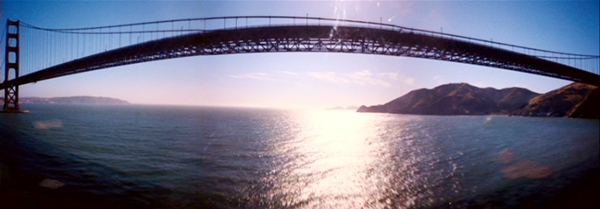
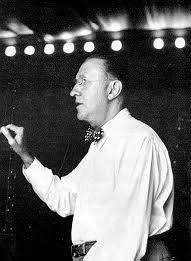
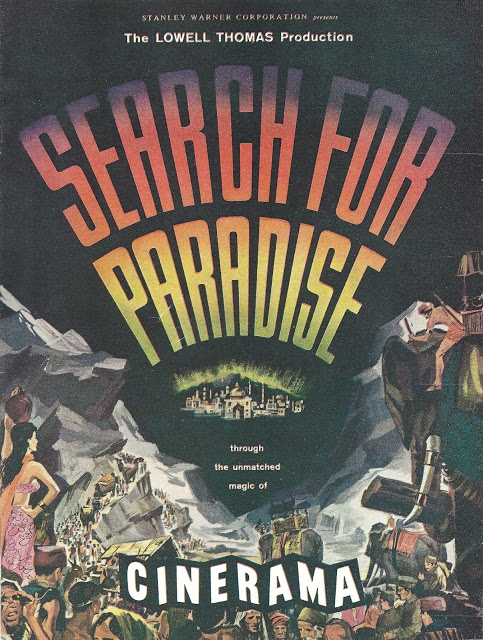
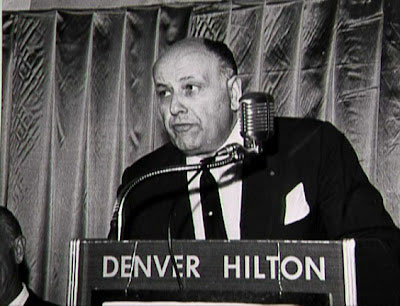 Reeves’s proven management skills might have turned Cinerama around even then if he had taken the reins in a firm hand, but evidently that was never his intention. With hindsight, it appears that Reeves was simply tired of dealing with Cinerama; his concerted efforts to streamline Cinerama’s corporate structure may have been just a way of getting it in good order — like a real-estate speculator fixing up and flipping a rundown house — so he could sell it and roll the capital into his own company, Reeves Soundcraft. In any event, Reeves had control of Cinerama for less than a year before he put it on the market — negotiating first with Walter Reade Jr. of Reade Theatres, then with Nicolas Reisini of Robin International. In the end Reisini bought Reeves out, becoming president and CEO of Cinerama Inc. (In his history of Cinerama, Thomas Erffmeyer mentions that in 1947 Reisini had purchased a California asbestos mine for $350,000 — which now, in 1959, he sold for $4 million. Dr. Erffmeyer doesn’t say if it was this windfall which enabled Reisini to buy Cinerama Inc., but it strikes me as a logical inference.)
Reeves’s proven management skills might have turned Cinerama around even then if he had taken the reins in a firm hand, but evidently that was never his intention. With hindsight, it appears that Reeves was simply tired of dealing with Cinerama; his concerted efforts to streamline Cinerama’s corporate structure may have been just a way of getting it in good order — like a real-estate speculator fixing up and flipping a rundown house — so he could sell it and roll the capital into his own company, Reeves Soundcraft. In any event, Reeves had control of Cinerama for less than a year before he put it on the market — negotiating first with Walter Reade Jr. of Reade Theatres, then with Nicolas Reisini of Robin International. In the end Reisini bought Reeves out, becoming president and CEO of Cinerama Inc. (In his history of Cinerama, Thomas Erffmeyer mentions that in 1947 Reisini had purchased a California asbestos mine for $350,000 — which now, in 1959, he sold for $4 million. Dr. Erffmeyer doesn’t say if it was this windfall which enabled Reisini to buy Cinerama Inc., but it strikes me as a logical inference.)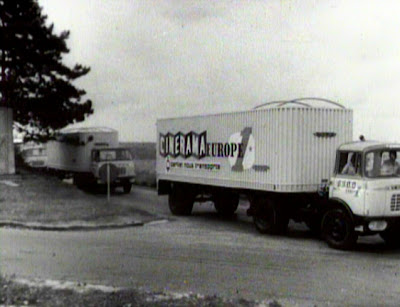
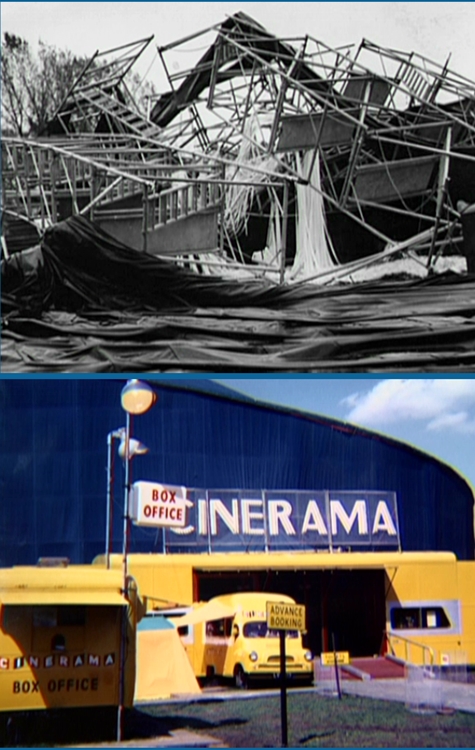

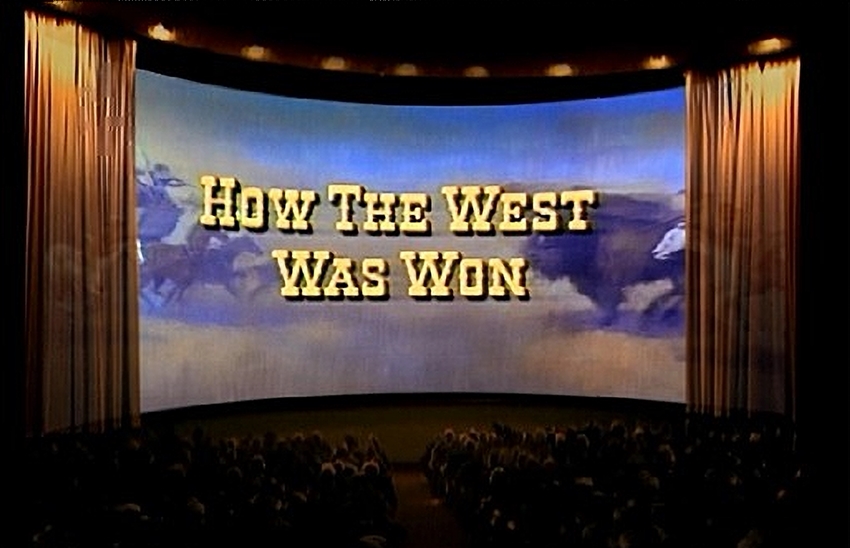

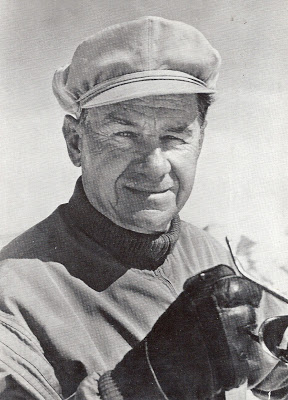
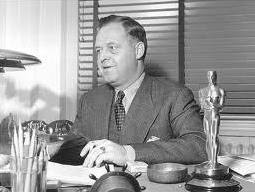
 Cinerama Inc. made most of its money from the equipping of Cinerama theaters — the sale or lease of equipment and supplying of replacement parts — and was annoyed that Stanley Warner wasn’t opening theaters at a quicker pace. The remaining investors in Cinerama Productions were annoyed that SW wasn’t opening more theaters and producing a steadier stream of pictures to show in them. And Stanley Warner, who had to put up all the money for both the theaters and the pictures but had to share almost half of any profits (when operating costs alone could eat up as much as 90 percent of gross ticket sales), was beginning to wonder if investing in the process had been such a good idea in the first place. The cracks among the partners in Cinerama were beginning to show, and were the subject of chatter in the trade press.
Cinerama Inc. made most of its money from the equipping of Cinerama theaters — the sale or lease of equipment and supplying of replacement parts — and was annoyed that Stanley Warner wasn’t opening theaters at a quicker pace. The remaining investors in Cinerama Productions were annoyed that SW wasn’t opening more theaters and producing a steadier stream of pictures to show in them. And Stanley Warner, who had to put up all the money for both the theaters and the pictures but had to share almost half of any profits (when operating costs alone could eat up as much as 90 percent of gross ticket sales), was beginning to wonder if investing in the process had been such a good idea in the first place. The cracks among the partners in Cinerama were beginning to show, and were the subject of chatter in the trade press. There had been talk of plans to expand Cinerama into foreign countries almost from the first opening in September 1952, but nothing had ever come of that idea. In the spring of 1954, Stanley Warner sought to farm out the foreign exhibition rights — find somebody who would foot the bill for overseas expansion and pay SW for the privilege. After three months of negotiations, S.H. Fabian hammered out a deal with Nicolas Reisini, president of Robin International.
There had been talk of plans to expand Cinerama into foreign countries almost from the first opening in September 1952, but nothing had ever come of that idea. In the spring of 1954, Stanley Warner sought to farm out the foreign exhibition rights — find somebody who would foot the bill for overseas expansion and pay SW for the privilege. After three months of negotiations, S.H. Fabian hammered out a deal with Nicolas Reisini, president of Robin International.
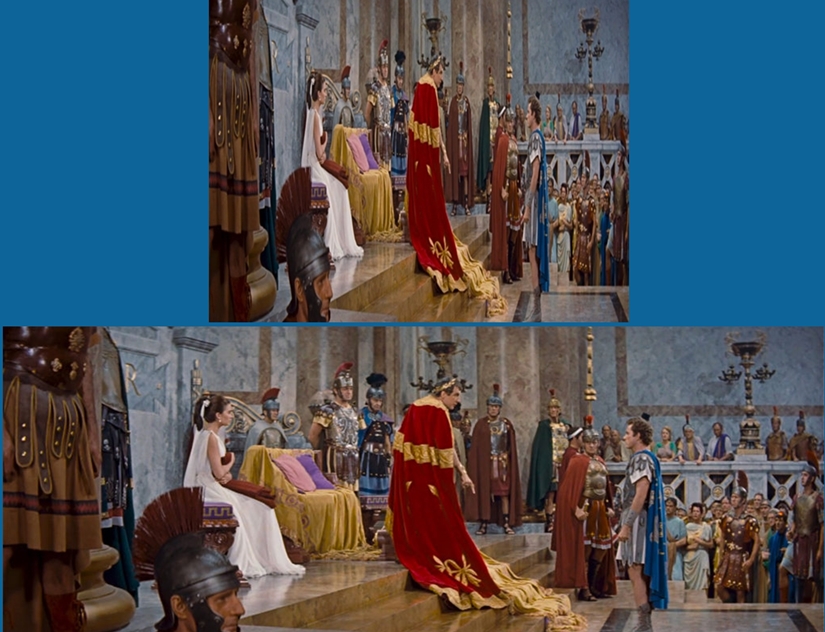 Remember all those movie-industry honchos trekking out to Oyster Bay to see Cinerama? One of them was Joseph M. Schenck, chairman of the board of 20th Century Fox. Like everybody else, Schenck passed on Cinerama, but as he did so he added ruefully: “I’ll be buying this process someday, and it will cost me ten times as much.”
Remember all those movie-industry honchos trekking out to Oyster Bay to see Cinerama? One of them was Joseph M. Schenck, chairman of the board of 20th Century Fox. Like everybody else, Schenck passed on Cinerama, but as he did so he added ruefully: “I’ll be buying this process someday, and it will cost me ten times as much.”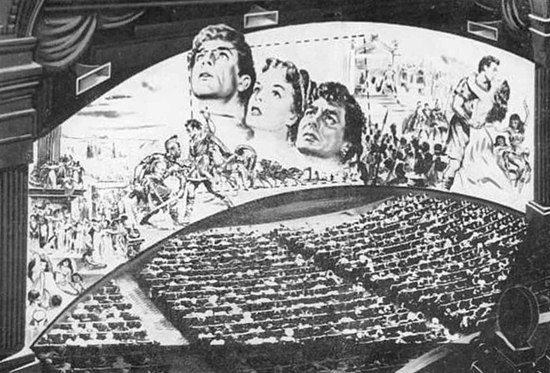 Early ads for CinemaScope, like the one I’ve reproduced here, emphasized a resemblance to both Cinerama and 3-D (“It’s the miracle you see without glasses!”) that didn’t really exist. While CinemaScope did originally call for a curved screen, most theaters didn’t bother with that. Even in The Robe‘s first-run engagements, the curve was much shallower than in this ad, and nowhere near as deep as Cinerama’s. (A good thing, too: you have to feel sorry for that poor sucker on the left end of the seventh row — what kind of view could he have had?) Anybody who compared Cinerama and CinemaScope side-by-side (so to speak) could see there was no real comparison. But in truth, most moviegoers couldn’t do that. Among Hollywood professionals, CinemaScope didn’t have to be as good as Cinerama, as long as they could sell it that way to the millions who hadn’t yet seen the real McCoy. Besides, it was still a huge change from movies-as-usual, and something folks couldn’t get on those newfangled 17-inch black and white TV screens in their living rooms.
Early ads for CinemaScope, like the one I’ve reproduced here, emphasized a resemblance to both Cinerama and 3-D (“It’s the miracle you see without glasses!”) that didn’t really exist. While CinemaScope did originally call for a curved screen, most theaters didn’t bother with that. Even in The Robe‘s first-run engagements, the curve was much shallower than in this ad, and nowhere near as deep as Cinerama’s. (A good thing, too: you have to feel sorry for that poor sucker on the left end of the seventh row — what kind of view could he have had?) Anybody who compared Cinerama and CinemaScope side-by-side (so to speak) could see there was no real comparison. But in truth, most moviegoers couldn’t do that. Among Hollywood professionals, CinemaScope didn’t have to be as good as Cinerama, as long as they could sell it that way to the millions who hadn’t yet seen the real McCoy. Besides, it was still a huge change from movies-as-usual, and something folks couldn’t get on those newfangled 17-inch black and white TV screens in their living rooms.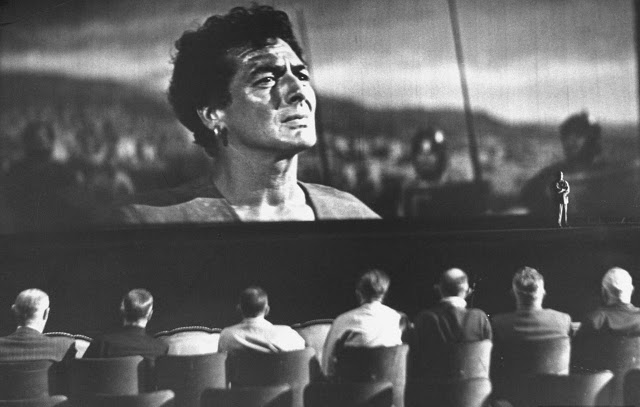
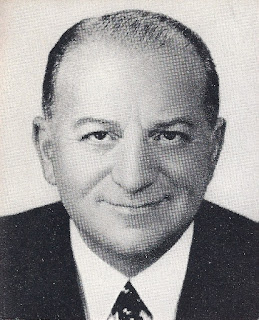
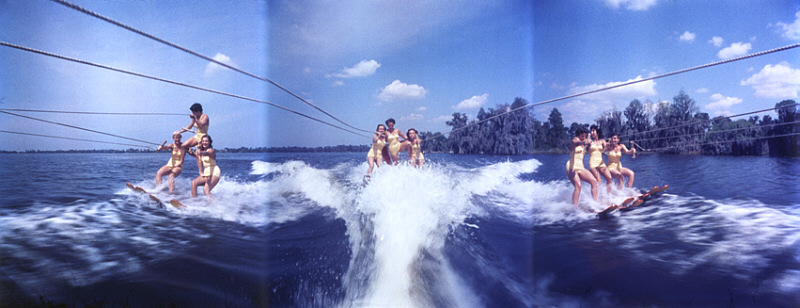 Lowell Thomas decided right off the bat — and Merian Cooper, when he came aboard, concurred — that the star of the first Cinerama picture would be Cinerama itself. “If Charlie Chaplin had offered to do Hamlet for us,” Thomas remembered, “I’d have turned him down. I didn’t want people judging Chaplin or rediscovering Shakespeare…The advent of something as new and important as Cinerama was a major event in the history of entertainment and I was determined to let nothing upstage it.” In other words, This Is Cinerama wasn’t a movie, it was a demonstration, just like Waller and Reeves’s screenings at their tennis court command post in Oyster Bay. The difference this time was that the presentation was more organized and formal, with tuxedo-clad personnel escorting the audience to their seats — and it was in Technicolor. (Mostly, anyhow; when opening night loomed and the feature was still a little short, Thomas and Cooper decided to splice in Waller’s black-and-white clip of the Long Island Choral Society singing Handel’s Hallelujah Chorus — it made a good demo of the sound system, with an invisible choir marching down the aisles of the theater before coming into view on the screen.) So in a sense, Cinerama was exactly where it was before the opening — only now the whole world was watching.
Lowell Thomas decided right off the bat — and Merian Cooper, when he came aboard, concurred — that the star of the first Cinerama picture would be Cinerama itself. “If Charlie Chaplin had offered to do Hamlet for us,” Thomas remembered, “I’d have turned him down. I didn’t want people judging Chaplin or rediscovering Shakespeare…The advent of something as new and important as Cinerama was a major event in the history of entertainment and I was determined to let nothing upstage it.” In other words, This Is Cinerama wasn’t a movie, it was a demonstration, just like Waller and Reeves’s screenings at their tennis court command post in Oyster Bay. The difference this time was that the presentation was more organized and formal, with tuxedo-clad personnel escorting the audience to their seats — and it was in Technicolor. (Mostly, anyhow; when opening night loomed and the feature was still a little short, Thomas and Cooper decided to splice in Waller’s black-and-white clip of the Long Island Choral Society singing Handel’s Hallelujah Chorus — it made a good demo of the sound system, with an invisible choir marching down the aisles of the theater before coming into view on the screen.) So in a sense, Cinerama was exactly where it was before the opening — only now the whole world was watching. 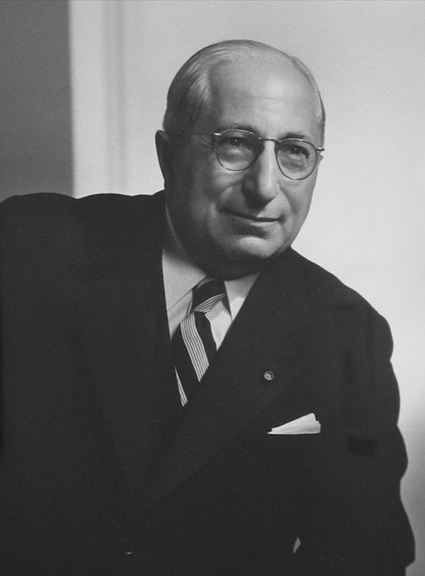 The first new development, barely three weeks after the premiere, was the appointment of Louis B. Mayer as chairman of the board of Cinerama Productions Corp. (with Lowell Thomas stepping down to vice-chairman). There was a certain irony in this; Mayer was one of the movie industry figures who trooped out to Long Island for those demonstrations, only to take a pass on investing. Back then, Mayer had been probably the most powerful man in Hollywood, but this was now. In the interim there had been that ugly power struggle at MGM between Mayer and Dore Schary, ending in a humiliating palace coup that sent Mayer packing in July 1951. By October ’52, Mayer was restless in forced retirement, and Cinerama looked like his passport back into the business. For Cinerama it was a windfall in both money (Mayer’s personal investment reportedly amounted to over $1 million) and prestige: Mayer’s status as a pioneer and longtime chief of the Tiffany of Hollywood studios gave an aura of solidity to Cinerama, and his reputation for showbiz acumen was expected to reassure and attract investors. He brought along some possible material, too: Mayer personally held the screen rights to several properties. One of them, Blossom Time, a moldy Viennese operetta of the sort Mayer had once so lovingly dusted off for Nelson Eddy and Jeanette MacDonald, would never do. But others might work very nicely, like the Lerner and Loewe musical Paint Your Wagon and the Biblical epic Joseph and His Brethren.
The first new development, barely three weeks after the premiere, was the appointment of Louis B. Mayer as chairman of the board of Cinerama Productions Corp. (with Lowell Thomas stepping down to vice-chairman). There was a certain irony in this; Mayer was one of the movie industry figures who trooped out to Long Island for those demonstrations, only to take a pass on investing. Back then, Mayer had been probably the most powerful man in Hollywood, but this was now. In the interim there had been that ugly power struggle at MGM between Mayer and Dore Schary, ending in a humiliating palace coup that sent Mayer packing in July 1951. By October ’52, Mayer was restless in forced retirement, and Cinerama looked like his passport back into the business. For Cinerama it was a windfall in both money (Mayer’s personal investment reportedly amounted to over $1 million) and prestige: Mayer’s status as a pioneer and longtime chief of the Tiffany of Hollywood studios gave an aura of solidity to Cinerama, and his reputation for showbiz acumen was expected to reassure and attract investors. He brought along some possible material, too: Mayer personally held the screen rights to several properties. One of them, Blossom Time, a moldy Viennese operetta of the sort Mayer had once so lovingly dusted off for Nelson Eddy and Jeanette MacDonald, would never do. But others might work very nicely, like the Lerner and Loewe musical Paint Your Wagon and the Biblical epic Joseph and His Brethren.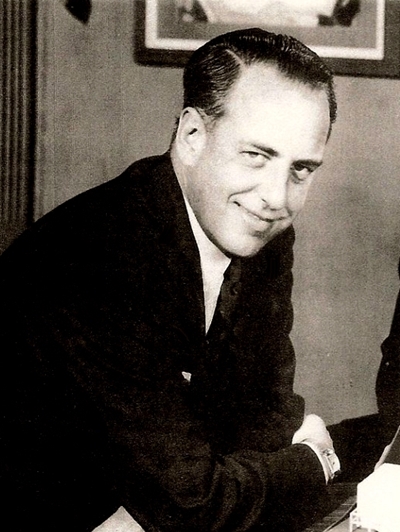 There was a flurry of announcements in trade papers. Dudley Roberts, president of Cinerama Productions, said Cinerama would open theaters in 100 cities, to be supplied with six to eight full-length features a year. Merian Cooper, now head of production, promised that Cinerama would either buy or build its own studio in Hollywood. (Might Cooper have had his eye on RKO? The studio was then in the process of being run into the ground by Howard Hughes, and ripe for the picking. If so, it didn’t happen; when RKO finally sold it went first to General Tire and Rubber Co., then to Lucille Ball and Desi Arnaz, who renamed it Desilu.)
There was a flurry of announcements in trade papers. Dudley Roberts, president of Cinerama Productions, said Cinerama would open theaters in 100 cities, to be supplied with six to eight full-length features a year. Merian Cooper, now head of production, promised that Cinerama would either buy or build its own studio in Hollywood. (Might Cooper have had his eye on RKO? The studio was then in the process of being run into the ground by Howard Hughes, and ripe for the picking. If so, it didn’t happen; when RKO finally sold it went first to General Tire and Rubber Co., then to Lucille Ball and Desi Arnaz, who renamed it Desilu.) 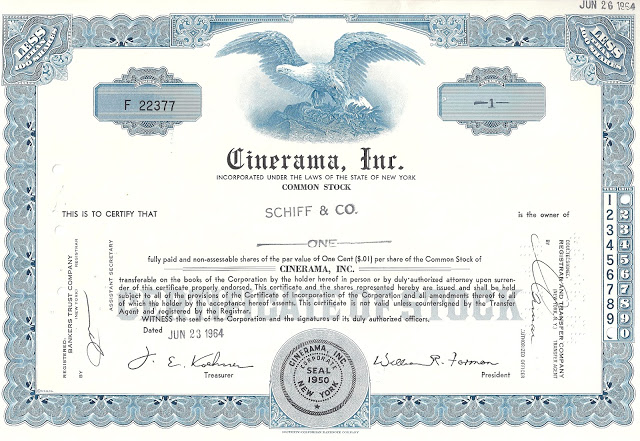

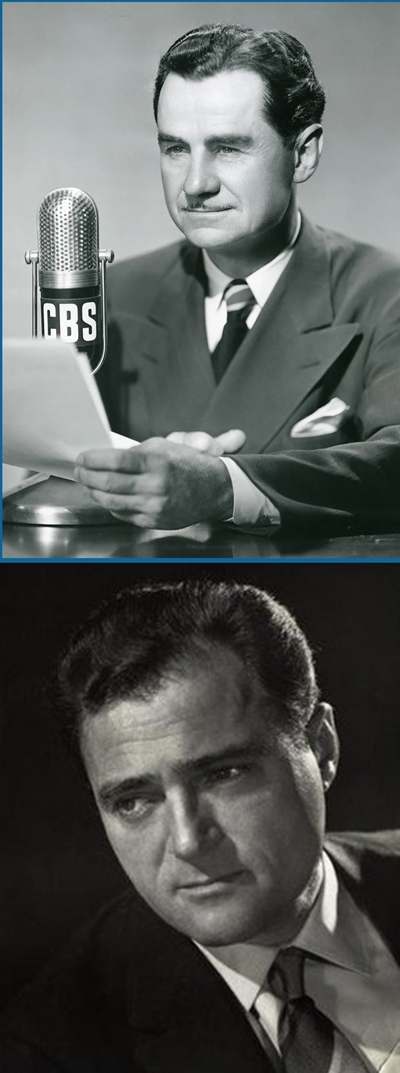 When Rockefeller and Luce bailed on Cinerama in July 1950, those other East Coast investors decided to take a pass as well, and Cinerama Corp. was dissolved in August. After buying out Rockefeller and Luce for a song, Hazard Reeves doubled down — he quite a bit more than doubled, in fact. In September he formed a new corporation, Cinerama Inc., in which Reeves Soundcraft was the principal stockholder, and set about tackling the challenges of moving Cinerama forward. The demonstration screenings at the converted tennis court continued. There were nibbles from independent producer Hal B. Wallis and a consortium of theater owners, but nothing came of them.
When Rockefeller and Luce bailed on Cinerama in July 1950, those other East Coast investors decided to take a pass as well, and Cinerama Corp. was dissolved in August. After buying out Rockefeller and Luce for a song, Hazard Reeves doubled down — he quite a bit more than doubled, in fact. In September he formed a new corporation, Cinerama Inc., in which Reeves Soundcraft was the principal stockholder, and set about tackling the challenges of moving Cinerama forward. The demonstration screenings at the converted tennis court continued. There were nibbles from independent producer Hal B. Wallis and a consortium of theater owners, but nothing came of them.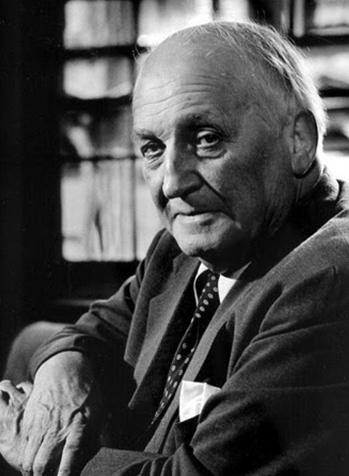 Also in early 1951 Thomas-Todd, or so the story goes, approached documentary master Robert Flaherty to direct the first Cinerama picture. Flaherty reportedly agreed, but he died in July ’51 as shooting was about to begin, leaving behind no notes or records to indicate what, if anything, he intended to do with Fred Waller’s process. This put Thomas and Todd back at square one.
Also in early 1951 Thomas-Todd, or so the story goes, approached documentary master Robert Flaherty to direct the first Cinerama picture. Flaherty reportedly agreed, but he died in July ’51 as shooting was about to begin, leaving behind no notes or records to indicate what, if anything, he intended to do with Fred Waller’s process. This put Thomas and Todd back at square one.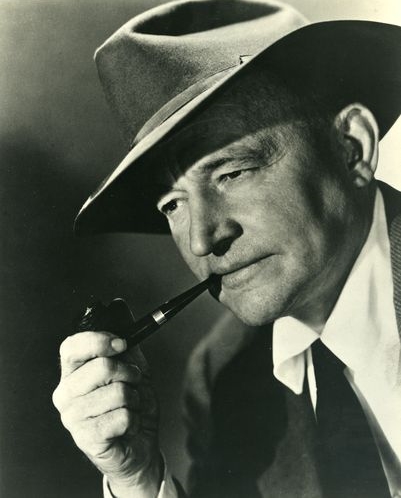 When all this footage was edited together in late 1951, it became clear that there wasn’t enough to make a full feature picture, so Thomas invited his friend Merian C. Cooper to come aboard. Even today, Cooper’s most famous production remains the original King Kong, but he has other ornaments on his résumé too: he was an early investor in the Technicolor process, and he partnered with John Ford on several of the director’s classic films: Fort Apache (1948), She Wore a Yellow Ribbon (’49), Wagon Master and Rio Grande (both ’50), with The Quiet Man (’52) and The Searchers (’56) still to come. Cooper had known Fred Waller in the early days at Paramount, and with that instinct for innovative ideas that made him an early passenger on the Technicolor bandwagon, he’d been following the industry buzz about Waller’s experiments out on Long Island.
When all this footage was edited together in late 1951, it became clear that there wasn’t enough to make a full feature picture, so Thomas invited his friend Merian C. Cooper to come aboard. Even today, Cooper’s most famous production remains the original King Kong, but he has other ornaments on his résumé too: he was an early investor in the Technicolor process, and he partnered with John Ford on several of the director’s classic films: Fort Apache (1948), She Wore a Yellow Ribbon (’49), Wagon Master and Rio Grande (both ’50), with The Quiet Man (’52) and The Searchers (’56) still to come. Cooper had known Fred Waller in the early days at Paramount, and with that instinct for innovative ideas that made him an early passenger on the Technicolor bandwagon, he’d been following the industry buzz about Waller’s experiments out on Long Island. 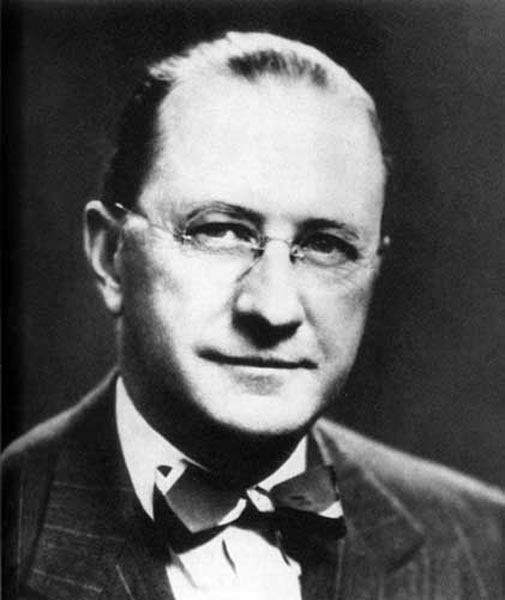 If there were such thing as a Dictionary of Stereotypical Characters, the entry for “eccentric inventor” would have a picture of Fred Waller. In the 1920s and ’30s, Waller’s day job was at Paramount’s East Coast studios in Astoria, Long Island, where he worked as a photographic jack of all trades. In one capacity or another he worked on, among other pictures, Male and Female (1921) for Cecil B. DeMille, and That Royle Girl (’25) and The Sorrows of Satan (’26) for D. W. Griffith. In the ’30s he produced and directed a series of innovative and visually striking jazz-flavored shorts featuring the likes of Cab Calloway, Duke Ellington and Fats Waller.
If there were such thing as a Dictionary of Stereotypical Characters, the entry for “eccentric inventor” would have a picture of Fred Waller. In the 1920s and ’30s, Waller’s day job was at Paramount’s East Coast studios in Astoria, Long Island, where he worked as a photographic jack of all trades. In one capacity or another he worked on, among other pictures, Male and Female (1921) for Cecil B. DeMille, and That Royle Girl (’25) and The Sorrows of Satan (’26) for D. W. Griffith. In the ’30s he produced and directed a series of innovative and visually striking jazz-flavored shorts featuring the likes of Cab Calloway, Duke Ellington and Fats Waller.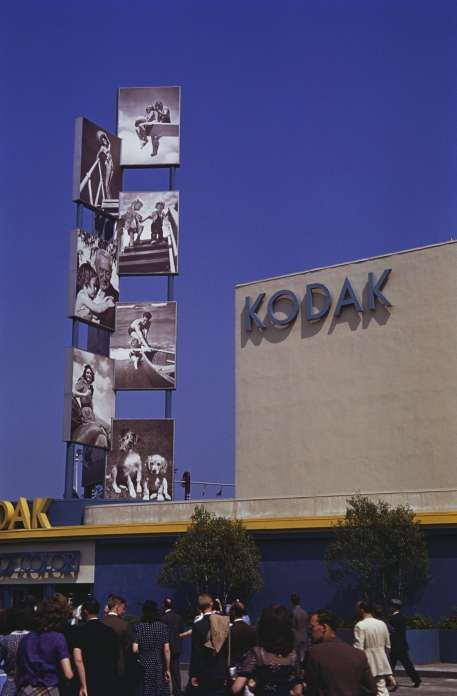 In 1938, architect Ralph Walker came to Waller with a unique photography challenge connected with an exhibit Walker was designing for the petroleum industry for the upcoming New York World’s Fair. Walker envisioned a spherical room with a battery of projectors casting a constant stream of moving pictures, an idea that dovetailed neatly with what Waller had been turning over in his own head. With Walker’s firm, Waller formed the Vitarama Corporation, and by early 1939 he had a working model of eleven 16mm projectors showing a patchwork image on a concave quarter-dome screen suspended over the heads of the audience.
In 1938, architect Ralph Walker came to Waller with a unique photography challenge connected with an exhibit Walker was designing for the petroleum industry for the upcoming New York World’s Fair. Walker envisioned a spherical room with a battery of projectors casting a constant stream of moving pictures, an idea that dovetailed neatly with what Waller had been turning over in his own head. With Walker’s firm, Waller formed the Vitarama Corporation, and by early 1939 he had a working model of eleven 16mm projectors showing a patchwork image on a concave quarter-dome screen suspended over the heads of the audience.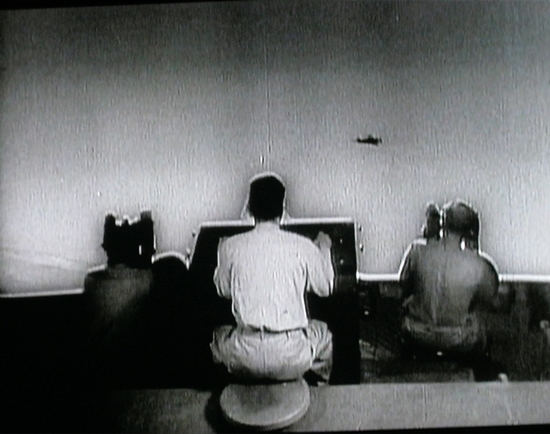 With a massive influx of military money (Waller later estimated it at over $5 million), the Waller Flexible Gunnery Trainer was born. It simplified the Vitarama design, using five 35mm projectors to display the same size image as the eleven 16mm ones, and it enabled Waller to work out the technical challenges involved in both the process itself and the manufacture of the equipment. Eventually 75 trainers, each occupying an area of some 27,000 cubic feet, were set up all over the U.S., in Hawaii, and in England, where over a million men were trained; the Air Force estimated that more than 250,000 casualties were averted thanks to this training.
With a massive influx of military money (Waller later estimated it at over $5 million), the Waller Flexible Gunnery Trainer was born. It simplified the Vitarama design, using five 35mm projectors to display the same size image as the eleven 16mm ones, and it enabled Waller to work out the technical challenges involved in both the process itself and the manufacture of the equipment. Eventually 75 trainers, each occupying an area of some 27,000 cubic feet, were set up all over the U.S., in Hawaii, and in England, where over a million men were trained; the Air Force estimated that more than 250,000 casualties were averted thanks to this training.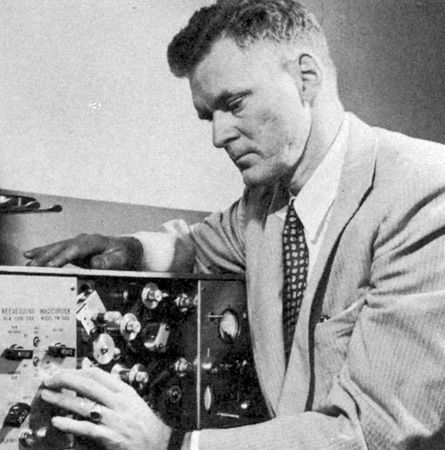 Also coming aboard at this time was Hazard E. “Buz” Reeves, one of the most brilliant and inventive men in the history of sound recording. Reeves had seen Vitarama as early as 1940, and was excited at the prospect of developing a sound system to go with it. Reeves and his company, Reeves Soundcraft, pioneered the use of magnetic recording for movies, a method more versatile than the standard practice of optical sound recording.
Also coming aboard at this time was Hazard E. “Buz” Reeves, one of the most brilliant and inventive men in the history of sound recording. Reeves had seen Vitarama as early as 1940, and was excited at the prospect of developing a sound system to go with it. Reeves and his company, Reeves Soundcraft, pioneered the use of magnetic recording for movies, a method more versatile than the standard practice of optical sound recording.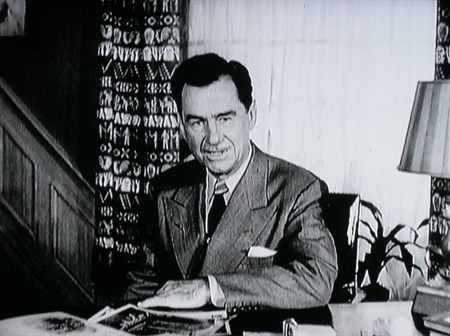 Spectators at that first showing on September 30, 1952 walked into an auditorium dominated by a huge curved wall of wine-red curtains. As the house lights dimmed, they heard the Morse Code dit-dit-ditting that was familiar to them all as the intro to Lowell Thomas’s daily radio program. The red curtains parted slightly, and there was the image of Thomas himself, in black and white, on a standard-size movie screen, welcoming them.
Spectators at that first showing on September 30, 1952 walked into an auditorium dominated by a huge curved wall of wine-red curtains. As the house lights dimmed, they heard the Morse Code dit-dit-ditting that was familiar to them all as the intro to Lowell Thomas’s daily radio program. The red curtains parted slightly, and there was the image of Thomas himself, in black and white, on a standard-size movie screen, welcoming them.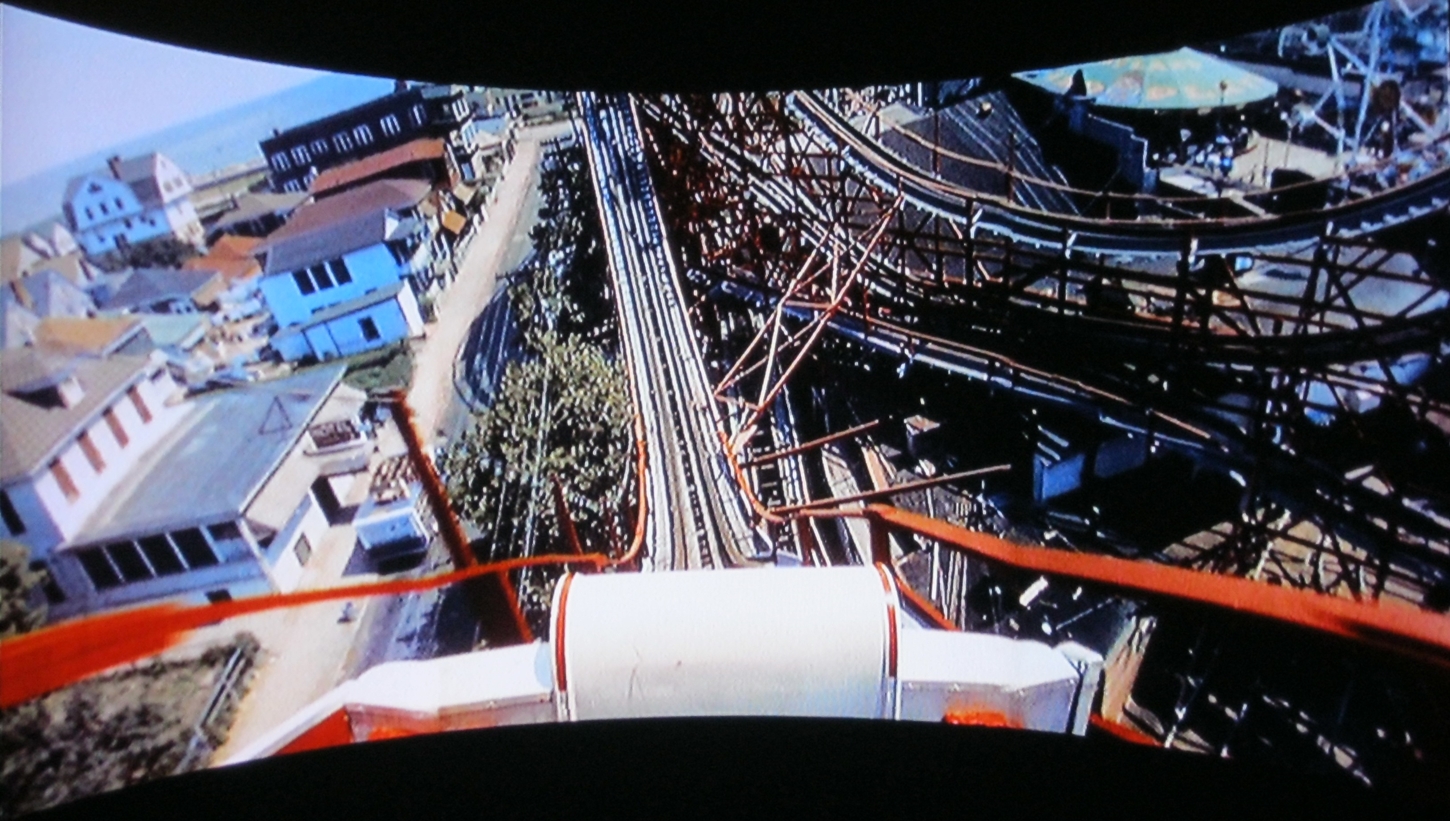
 My own father’s reaction was more succinct. My uncle took him, my mother and my grandparents to see This Is Cinerama when it opened at San Francisco’s Orpheum Theatre on Christmas Day 1953. As the curtains opened and the rollercoaster burst into view, my father reared back in his seat, his eyes bulging from their sockets, and bellowed at the top of his lungs: “Jeeee-zuss Christ!!” He may have been more vociferous than anyone else that day, but every single person in the Orpheum had exactly the same reaction. I know because when my own turn to see This Is Cinerama came 11 years later — even after a decade of CinemaScope, Todd-AO, Panavision, VistaVision, and all the other scopes and visions Cinerama had inspired — that Great Unveiling had lost none of its power. No two ways about it, this was — and remains — the greatest knockout punch in the history of motion pictures.
My own father’s reaction was more succinct. My uncle took him, my mother and my grandparents to see This Is Cinerama when it opened at San Francisco’s Orpheum Theatre on Christmas Day 1953. As the curtains opened and the rollercoaster burst into view, my father reared back in his seat, his eyes bulging from their sockets, and bellowed at the top of his lungs: “Jeeee-zuss Christ!!” He may have been more vociferous than anyone else that day, but every single person in the Orpheum had exactly the same reaction. I know because when my own turn to see This Is Cinerama came 11 years later — even after a decade of CinemaScope, Todd-AO, Panavision, VistaVision, and all the other scopes and visions Cinerama had inspired — that Great Unveiling had lost none of its power. No two ways about it, this was — and remains — the greatest knockout punch in the history of motion pictures.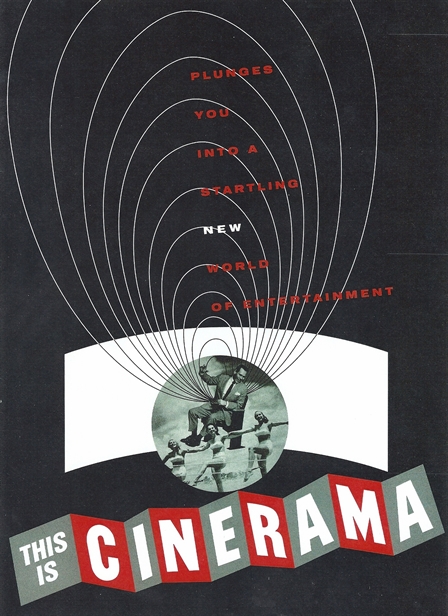
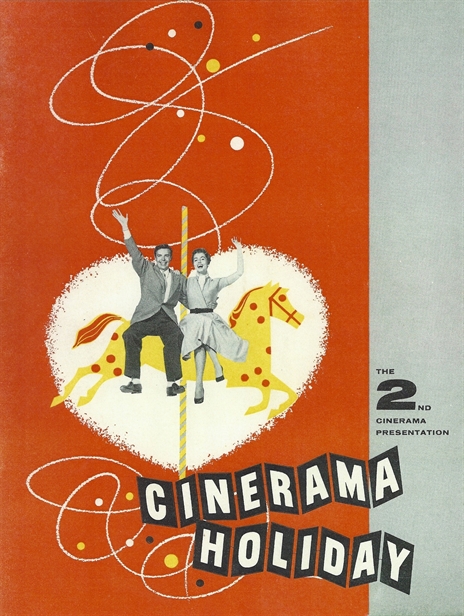
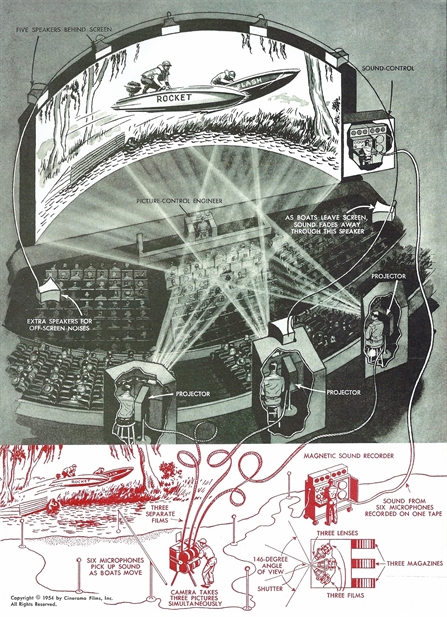 By the early ’50s things had changed — and besides, Cinerama was as different from those early pictures in Grandeur and Magnascope as FM radio was from AM. The screen wasn’t just wide, it was vast, curved 146 degrees to match almost the full range of human vision, using three synchronized projectors to display an image nearly five times the size of even the largest theater screen. And Cinerama had a multi-channel high-fidelity sound system for which a new term was coined: “stereophonic sound”.
By the early ’50s things had changed — and besides, Cinerama was as different from those early pictures in Grandeur and Magnascope as FM radio was from AM. The screen wasn’t just wide, it was vast, curved 146 degrees to match almost the full range of human vision, using three synchronized projectors to display an image nearly five times the size of even the largest theater screen. And Cinerama had a multi-channel high-fidelity sound system for which a new term was coined: “stereophonic sound”.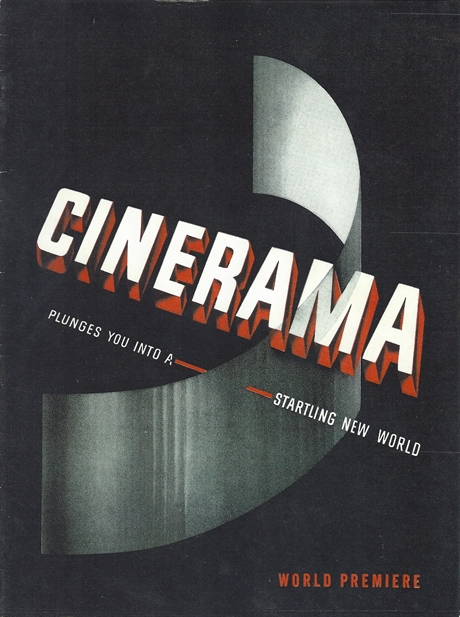 This coming September 30 will mark the 60th anniversary of Cinerama‘s premiere, and the occasion is not going unobserved. ArcLight Cinemas, which owns the Pacific Cinerama Dome in Hollywood (one of only three theaters in the world equipped to show true Cinerama) will be spending a week, from September 28 to October 4, presenting — to borrow the title of the second Cinerama production — a Cinerama Holiday. Every single Cinerama picture produced during the years Cinerama reigned as the Metropolitan Opera of movies will be on display, along with a couple of ringers — Cinerama’s Russian Adventure, an Americanized release of a picture produced by the Soviets in 1958 with pirated equipment and called Kinopanorama (then, typically of the time, the Russians accused us of stealing it from them); and Windjammer: The Voyage of the Christian Radich (1958), produced in a competing but compatible process called Cinemiracle — plus two movies that bore the Cinerama name even though they weren’t: It’s a Mad, Mad, Mad, Mad World (’64) and 2001: A Space Odyssey (’68).
This coming September 30 will mark the 60th anniversary of Cinerama‘s premiere, and the occasion is not going unobserved. ArcLight Cinemas, which owns the Pacific Cinerama Dome in Hollywood (one of only three theaters in the world equipped to show true Cinerama) will be spending a week, from September 28 to October 4, presenting — to borrow the title of the second Cinerama production — a Cinerama Holiday. Every single Cinerama picture produced during the years Cinerama reigned as the Metropolitan Opera of movies will be on display, along with a couple of ringers — Cinerama’s Russian Adventure, an Americanized release of a picture produced by the Soviets in 1958 with pirated equipment and called Kinopanorama (then, typically of the time, the Russians accused us of stealing it from them); and Windjammer: The Voyage of the Christian Radich (1958), produced in a competing but compatible process called Cinemiracle — plus two movies that bore the Cinerama name even though they weren’t: It’s a Mad, Mad, Mad, Mad World (’64) and 2001: A Space Odyssey (’68).